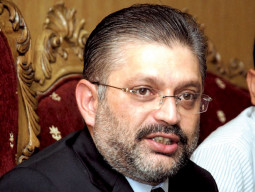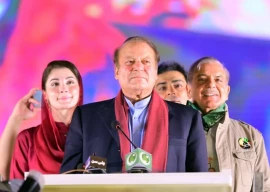
Now for the longer answer.
There is no doubt about who is killing the Shia. The Lashkar-e Jhangvi (LeJ) has repeatedly taken responsibility for it. Its captured terrorists have often stated before courts that they have killed Shias and, given the opportunity, will do it again. The identity of the killers is a settled issue.
Nota Bene: The issue of the proxy war between Saudi Arabia, the Gulf states and Iran, the funding to Sunni extremist groups and whatever is left of Shia extremists, and circumstantial evidence of indirect involvement of hostile agencies is important but peripheral to the main issue, i.e., the terrorists are Pakistanis and killing on the basis of centuries-old denominational differences. The current murderous spree, of course, has a modern political and geopolitical context.
A more relevant question is: if the group that is involved in these killings has not only been ID-ed but IDs itself, what is stopping the state from acting against it, and effectively?
This is where the problem begins.
The LeJ was begotten from the dark womb of the Sipah-e Sahaba Pakistan (SSP). The SSP, banned by Pervez Musharraf, has reincarnated itself as the Ahle Sunnat Wal Jamaat. It has a certain political presence. It is technically not the LeJ, even as de facto it is. LeJ terrorists, along with the hardline splinter group of Jaish-e Mohammad (JeM), have over the last five years, come to form the backbone of the Tehreek-e-Taliban Pakistan (TTP) conglomerate. The TTP is an entity that political parties now — the ANP included (in desperation) — want to talk to, even as the state considers the LeJ a terrorist entity.
So while the LeJ is a terrorist organisation providing manpower to the TTP, the state is being pressured to talk to the latter and give it the legitimacy of an insurgent group.
But this is not all. In Punjab, the ruling Pakistan Muslim League-Nawaz is in talks over seat adjustment with the ASWJ, the Dr Jekyll to its Edward Hyde, the LeJ. Leaving aside the PML-N’s petty lying about the issue, it is a fact that it wants to placate the LeJ through a dangerous liaison with the ASWJ. The general impression is that this is being done to win votes. That’s only partially true. The primary reason is that the PML-N doesn’t want mayhem in Punjab, its central vote bank, where it wants to win and win big through a lot of development work (even if lopsided) by Chief Minister Shahbaz Sharif.
The Faustian bargain is meant to keep the LeJ, and by extension the TTP, at bay. In other words, the PML-N is doing this for the same reasons that the ANP wants to talk to the TTP. The problem with this short-term approach is just that: it is short term and allows these groups the respite and the space to strengthen themselves and emerge as even more potent contenders against the state.
What about the army and the ISI; how do they look at this phenomenon?
Short answer: they are greatly worried. Next question: what are they doing about it?
Short answer: not much.
Central question: why the hell not? This requires a longer answer and some perspective.
Fact 1: The total strength of the army is about 550,000 troops. Out of this, around 110,000 are deployed in the operational areas in the west. Approximately 60,000 to 70,000 are deployed along the Line of Control as part of 10 Corps and Force Command Northern Areas. The rest are in peacetime locations, to be mobilised to defend the eastern border when required. Additionally, there are a number of other command and staff duties to be performed.
Fact 2: Armies generally operate on the 33.33 per cent principle. At any time, 33.33 per cent are deployed, the same percentage is in training and equal numbers, more or less, are resting and retrofitting. Pakistan’s internal war has thrown this awry. The deployment has gone up to 54 to 55 per cent, training retains the same percentage and the resting and retrofitting has gone down to about 12 percent. The ops areas tenure has upped from 22 months to over two years and a high percentage of units are now awaiting second and third rotation to the ops areas. Evidently a killer.
Fact 3: The Pakistan Military Academy has had to raise the 4th Pak Battalion because the internal war has taken a heavy toll of young officers. The officer-to-soldier kill ratio is very high, upped from 1:16 to 1:14 and now stands at 1:8. This means a shortage of YOs. (Some officers consider it a matter of pride; I consider it a weakness but that’s a separate topic.)
Corollary: the army is stretched thin. It cannot be everywhere and, quite apart from operations to wrest territory, is not meant to address the problem of urban terrorism. Even the counterterrorism sub-units in the Special Services Group, like the Zarar and Karar companies, are meant for fire-fighting, not gathering intelligence and pre-empting.
And the ISI? It has the capacity to gather intel and it does. But equally, there are other organisations like the police, the Intelligence Bureau and the CID units whose primary job is to gather intel. Why are they not effective? Answer: when political governments make alliances with the very terrorists these organisations are supposed to bust, then they cannot be effective. There are other reasons too but this is the primary one.
And when Frontier Corps does get involved, sending terrorists to their afterlife, as in Quetta, the leaders of these organisations invoke the law and register cases against the FC. Recently, the new Inspector General Police (IG) Balochistan met with LeJ leaders and defended this by saying the police have to reach out to them.
The question is: if the LeJ is a banned terrorist organisation, how are these leaders at large and meeting the IG?
The confusion gets confounded. More on this next time.
Published in The Express Tribune, February 27th, 2013.
COMMENTS (58)
Comments are moderated and generally will be posted if they are on-topic and not abusive.
For more information, please see our Comments FAQ




























1714024018-0/ModiLara-(1)1714024018-0-270x192.webp)









More shameful apologist excuses for the army and intelligence security services, and the continuing of the false and unbalanced 2 sides proxy claim (sectarian 'conflict') which the author has employed before to downplay the crisis of actual sectarian genocide and only partially admits now.
They can very well move to dismantle networks such as J-e-M, L-e-T, Haqqani network, Quetta Shura and L-e-J, who all have contacts with one another including the Taliban, TTP and Al Qaeda and indulged in anti-Shia massacres, amongst others, and the author and those serving know it but have only shown more willingness in exercises such as memo-gate and locking up Dr. Afridi. The same old militant 'usefulness' for regional purposes continues to dominate among the officers, and no retired officer is ever held to account for their frequent meetings with these groups. The army is made up of the same Pak population with growing extremist views and bias against the minority.
@Raj Apart from what has been mentioned, one of our COAS who was killed in aircraft crash was a shia. I know many serving generals / relatives who are shia. But sometimes your hands are tied.
Manoj, Why ask me to enlighten you, when your culture and traditions resist enlightenment. My english is not good but let me restate, Indians do not EASILY integrate with peoples of OTHER CULTURES, Perhaps, I should have said , " in the believers world or the western christian world. To be honest and to answer your question, I do not see much difference between the Indian hindu from Karachi, bombay or Montreal. Nor does this imply that Indian cuturural values are in any way inferior to those of other peoples of the world. I am not impressed from the violence in Pakistan, which can be brought under control by a competent Govt., nor am I impressed by the rape culture of Indians against their women which according to Indian police it is imbeded in Bharatya culture, whatever this means.
Yes, your statement about my ignorance of the hindu culture is correct! Plas no mor surprises! Namaste.
Rex Minor
I disagree with the bias .... In Pakistan you are on your own, whoever you are !!!!
Rex Minor, When you say 'indians do not integrate well with other people', you give-away your extreme ignorance about who an Indian is and what cultural values he carries with it-around the globe. Tell me something. Is a 75 year old Hindu Sindhi(orginally from karachi) an Indian as per your definition of nationalities? His family could be traced 500 yrs back to Karachi till he was forced to move during the partition of 1947. Did he lose his 'good' values when he his family moved to post 1947 India ? More importantly, could he salvage the values that could redeem the social side of his personality by moving back to Pakistan or changing his religion? Please enlighten me.
If an Ahmedi, you have the civil society, military, judiciary, media and the politicians supporting you! If the Ahmediyya carnage of May 2010, was condemned and perpetrators brought to justice then Shia killings could be prevented.
@Punjaagi:
Every sixth person in the world is from India! They have spread across the world but usualy do not easily integrate with peoples of other cultures. As humans we all have our egoes, but the social side of our personality require that we have contacts with humans. Indians feel let down by those who have separated from them or conspire to separate from them because of non compatibility of the believers with non believers. What you observe is the love hate relation of two people..
Rex Minor
@Arzoo: My bad. I misunderstood what Raj - USA was saying. But the point I made I think still holds though I see the point you are making in the context of the recent increase in Shia sectarian killing.
@Arzoo: Many thanks for your info. I stand corrected. Pakistan was not that bad. Considering the politeness and openness in your reply, Pakistanis are also not that bad as portrayed. As far as Zardari (not all his party members) is concerned, I consider him as a secular person who has no serious religious bias and least concerned of the sect. He may however, at times, portray to be religious when the situation demands. Thanks a lot again Brother.
@Arzoo: "While one may have difficulty disagreeing with you on many points, interestingly yes, Pakistan can have a Shia COAS."
Shias are Muslims. Having a Shi COAS does not meet the comparison. If a Hindu, Christian, SIkh or Ahmadi were to be a COAS then it would be comparable. That is the point he had made i.e. do not give example of a Shia COAS or any other senior Shia in power.
Shias have no where to go now there are a few million in Pakistan say 10% makes it 10 milion people roughly its a quagmire
@Raj - USA: Can Pakistan ever have a Shia COAS or chief of ISI or even a 3 or 2 star general? Shias are muslims.
While one may have difficulty disagreeing with you on many points, interestingly yes, Pakistan can have a Shia COAS. Agha Muhammad Yahya Khan, who later became the President, and General Musa Khan were two COAS that come to my mind. And General Musa was actually a Hazara Shia. And, you may find it of interest that Zulfiqar Ali Bhutto, his daughter, and our current President, Asif Ali Zardari are all Shias. Pakistan's cross-currents are much too complex to be stated in simple terms as you have made it out to be. The Cold War and other Geo-political complexities and Pakistan's own culpability have played significant role in the present day mess. But, rest assured, as difficult as it seems now, from the maze of lost ways Pakistan and its' citizens will yet again emerge to build a prosperous future.
What Mr Jinnah said about Hindus and Muslims living together in a state ( 2 nation theory ) can be re-stated with minor modification by the chief of Lashker-e-Jhanvi about Sunnis and Shias living in the same state ( 2 sect theory ). Do you see the parallels ?
ET: This is the second time I am trying to respond to a message that was directed at me. My message meets all your guidelines. Please allow rebuttal.
@Punjaagi: "You dont worry about the men coming in boats to India and take a look at Chuck HAgel’s statement that Indian finances troubles for Pakistan through Afghanistan. Those who live in house of glass should not throw stones at others, unless you have no self respect of course which seems to be the case with you."*
IF terrorists come from Pakistan to India, the Indians will worry. Chuck Hagel may very well not be right since in 2011 when Hagel made this statement, Hillary who was secretary of State had indicated that there was no evidence of India being involved in terrorism in Pakistan. He was not part of the government and this could be his opinion not based on fact. Assuming Chuck Hagel is right, then the Pakistani citizens have a right o be concerned. Ask your government why it does nothing to prevent India from fomenting terror in Pakistan. Ask your government why it has not presented any evidence to the world or even to India in this regards I did want to tell yo that in India you will not find anti-Pakistan wall chalkings all over the place, nor do people collect funds outside mandir, masjids, gurudwaras for war against Pakistan nor do the textbooks attempt to indoctrinate against Pakistan on religious lines.In any case I find it really difficult to believe that highly religious groups like LeJ would accept funds from 'Hindu India' to kill their fellow Muslim brethren.@Polpot: "Do you know gp in gp65 stands for Genuine Pakistani."
Lol. I am definitely an Indian and have never claimed otherwise.
The strategic assets are required for the 2014 strategic depth Afghan operations and thus they are being treated like state guests.But what will they do in 2013?Practise their bombing and shooting skills with Shias as targets??
The Kurds and Shias of Iraq faced a similar situation in 1991.The solution by the UN security council was creation of safe havens by establishing of a no fly zones.
@John the Baptist: Let me put it humbly- Incredible India is not a mere paper slogan but a reality on ground which has been aptly put across by gp65.
@Punjaagi: "@gp65:The mere fact that the perspective is coming from an Indian robs it of any chance of taken seriously." +++++++++++++++++++++++++++++++++++++++++++++++++++ Do you know gp in gp65 stands for Genuine Pakistani.
Haider Bhai true picture,it is only Shia genocide just to foil Strategic Alliance between two most powerful mislim countries.All other muslim countries,USA,UK,NATO are determined nothing should take place between two.Biggest spoilers are KSA/USA.
@Punjaagi: unless you have no self respect of course which seems to be the case with you." +++++++++++++++++++++++++++++++++++++++++++++++++++ When you cannot refute the poster's logic , attack the poster. How typically Pakistani!.
@gp65: All you hope is to bring perspective to our attention. For a moment i will assume you are saying this out of utter sincerity. Even if you are sincere, which is doubtful, i would suggest that you do not bring anything to our attention. The mere fact that the perspective is coming from an Indian robs it of any chance of taken seriously. Much like the Indians here go on a rampage if i would point out something negative happening in India and you jump up to defend it, a previous exchange between you and someone else in this post a case in point. In any case, we do not need lectures from you. It's our country and we know the problems and the solutions. And those who do not not know the solutions are gradually coming around it. You dont worry about the men coming in boats to India and take a look at Chuck HAgel's statement that Indian finances troubles for Pakistan through Afghanistan. Those who live in house of glass should not throw stones at others, unless you have no self respect of course which seems to be the case with you.
I will to make it simple: If Pakistan had not nurtured these Gentlemen to fight India, which resulted in massive extremism, you wouldn't have had to face this scenario. In a way your hatred of India is harming you today.
If you are concentrating on talks, fighting,etc, and forget to correct this historical mistake of targeting foreign countries with Terror, you are bound to go over this cycle once again.
A blast took place in Hyderabad few days ago, I guess you all have still to learn your lessons.
@imran bhatt:
Brilliant Imran. Allow me to share.
@jawad: Excellent
@Hasan: I am sharing this with your permission. Brilliant.
A very articulate and analytical article mr Ejaz, enjoyed every bit of it, as always. But would differ a little bit, with the hurdles that you have put forward which more or less compel Pakistan Military for inaction, though what you have made very subtle points but still the inaction on their part exceeds the degree of caution that they should have exercised. nevertheless yes, young officers, of our Military have led from the front and have made ultimate sacrifices, hope their efforts and the resilience shown by every Pakistani is not wasted, by people who are supposed to do something.
The bar keeper at an hotel in Moscow asks the guest, " Excuse me sir, Are you an Irish"? The hotel guest answered angrily, " Is it not bad enough to be a Black"?. Barack Hussain Obama's father was a Kenyan muslim and mother an Irish American. Areal Sharon once said to a visiting jewish journalist that there is nothing worst than being born as a jew. The one is the President of the USA, and the other was the Prime Minister of Israel. :
I guess that it is not easy to be a member of the minority in a country where the people from the extreme right spectrum are loud and show no tolerence.
Rex Minor
"The confusion gets confounded. " ++++++++++++++++++++++ There is no confusion: the criminals and the victims are well known. The sentence should read: "The paralysis gets confounded. "
@Observer: "All Pakistan needs to do is to double the size of its army. " +++++++++++++++++++++++++++++++++++++++++++++ Great Idea , that will also solve the unemployment issue.
BTW what happened to the claim that 1 Pakistani soldier is equal to 10 Indian soldiers?
@Another North Indian: "Is it not better for the world to let Pakistan continue on its chosen path?" ++++++++++++++++++++++++++++++++++++++++++++++++++ the path that led to its breakup into Bangladesh and West Pakistan and now leading to a breakaway Baluchistan...
It is very simple. All Pakistan needs to do is to double the size of its army. This will give it the ability to increase the mischief against India and Afghanistan while providing more divisions to keep the Baloch under the thumb. The strategic depth game in Afghanistan can then be pursued with more vigor. It will also allow the Pak army to give more "moral, political and strategic" support to Kashmiris to fight the Indians.
All win-win formula from all aspects. All Pakistan needs to do is to muster national will to divert more resources to make this plan happen.
@John the Baptist: Another North Indian forgot to mention that the chief of intelligence bureau of India is also a Muslim! The United Colours of Benetton is no match to the diversity of colours of Indian secular democracy.
Regards
Both Shia and Sunnis are Mulsims and following Islam.
Shia and all other non Whabi Muslims and non Muslims are on their own we understand. What we do not understand that the army is so small and it is stretched so thin that it cannot do anything more than what it is already doing. The author and our nuclear armed huge army wants more resources to protect the genocide and ethnic cleansing of Shia. Isn't this their primary responsibility what else is more imp than protecting your own innocent citizens despite usurping most resources? Let us dismantle the army and arm our citizens to take care of themselves instead of dying like sitting ducks.
@Hasan: Hundreds of Sunni Ulema were killed, what else you want? Iran and Saudi Arabia are fighting a proxy war in Pakistan. In Saudi Arabia shias are oppresed as Sunnis in Iran, time has come all Pakistanis should behave as Pakistanis rather puppets of two most corrupted and terror financed countries like S. Arabia and Iran
@imran bhatt: I see your point, though Sharia laws would probably standardize an interpretation of Islam, and simply not having a beard or being born a Shia would not render you an apostate. You don't, for example , see Saudi Wahabbis chopping off Bahraini Shias, nor does Iran bombard Sunni baloch mosques. And neither, by the way, has the Sunni Shia conflict ever evolved into anything other than political differences. And there comes America, an oil boom, a Soviet invasion and ta da! Capitalism makes the two groups more hostile to one another than ever.
@Ali Tanoli:
Two type of comments from AT: mostly hate laced, ignorant and arrogant blabberring; some times senseless noise.
@kaidi 786,: Same goes to muslims, sikh, christians, untouchable hindus, poor indias, etc . Please read the following : . Coexistence with India – I : http://dawn.com/2013/02/05/coexistence-with-india/ . Coexistence with India – II : http://dawn.com/2013/02/19/coexistence-with-india-ii/ . Coexistence with India – III : http://dawn.com/2013/02/26/coexistence-with-india-iii/ . Coexistence with the world : http://dawn.com/2013/02/12/coexistence-with-the-world/ . You will find it very, very interesting and breath taking! Indeed it will take your breath away!! . Cheers
@kaidi 786,: @gp65: You say: One of the richest Indians by the way is Azim Premji a Muslim. The success of Muslims and SIkhs in Bollywood shows that ordinary Hindus do not hold any grudge on the basis of religion – or else their movies would not be hits.
It is the Pakistanis who are jealous and hold a grudge on the success of muslims, sikhs and christians of India. Rather than appreciating their success, they would try to put them down. India's muslim nuclear scientist became the President and inspiration for all. Pakistan's nuclear scientist aspires to become the President and calls Ahmedis traitors on live TV. I think Pakistani's have forgotten how Feroz Khan got angry and blasted Pakistan media anchors on live TV in Pakistan when they tried to insult Shilpa Shetty. Finally, India has Sikh COAS and has had many generals. Can Pakistan ever have a Shia COAS or chief of ISI or even a 3 or 2 star general? Shias are muslims. Aren't they? May be not so in Pakistan. The little Hazara girl carrying the placard "don't kill me. I am also a Muslim" knew what Pakistanis are thinking of shias. This was not the first time. I have seen such many times over in the last 2-3 years.
@Another North Indian: Fully agreed. We only need to make sure we help pakistani Hindus/Sikhs/Buddhists.
@Another North Indian:
What would you do if the home next to yours is on FIRE? Won't you be concerned and try to help extinguish the fire even if you do not have good terms with the neighbor? You don't want your home to engulf in the same fire. Do you?
Of course you can construct a fire-resistan wall. But that will take time and money.
@Another North Indian: "gp65, remember, you said you didn’t understand one of my posts. I will summarize it again: why are Indians so concerned about fixing Pakistan? Are Indians going to fix it? So long as Pakistan remains Pakistan, how will fixing it help anyone else? Is it not better for the world to let Pakistan continue on its chosen path?"
OK Thanks. I now get what you were saying earlier. I guess the key reason I care is because I differ from your view that if the hate and intolerance goes away, it will not benefit us, because I think it will. I believe that the infrastructure of hate they have built does impact us with people willing to get on boats and come to our cities. I just want to point out that it does not just hurt India, it also hurts them.
In any case no outsider can fix problems in a country. All I hope to do is bring some information and/or perspective to their attention and hope that Pakistani citizens see the linkage and ask for the change themselves.
@imran bhatt, Sharia law is system of running the country and its same in both islam shia or sunni. karbala was political problem after death of khaliph usman (r.a).
@gp65:
Not at all my friend, not at all. Our CJ is Muslim as is our foreign minister, our PM is SIkh as is our COAS, the head of the ruling party – SOnia Gandhi is Chrisian as is our defence minister and head of airforce. Untouchability is banned in India and the people who were formerly considered untouchables (called scheduled castes now) get reservations in education and jobs to make up for past injustice.
Sounds like the TV ad for United Colors of Benetton--no substance, pure marketing!
@gp65:
If you are gp65, you have a whole support network made up of US and indian neo cons!
Very informative piece of writing. Great questions raised. Hope someone is listening.
This is pretty much the definition of a failed state.
Is Ejaz admitting that Pakistan is a failed state?
And what about http://en.wikipedia.org/wiki/Responsibilitytoprotect ?
For those who demand Sharia laws in Pakistan, if Sharia cannot resolve this centuries old denominational issue among Muslims how on earth it can be trusted to bring about peace and development?
gp65, remember, you said you didn't understand one of my posts. I will summarize it again: why are Indians so concerned about fixing Pakistan? Are Indians going to fix it? So long as Pakistan remains Pakistan, how will fixing it help anyone else? Is it not better for the world to let Pakistan continue on its chosen path?
@kaidi 786,: "@gp65 Same goes to muslims, sikh, christians, untouchable hindus, poor indias, etc"
Not at all my friend, not at all. Our CJ is Muslim as is our foreign minister, our PM is SIkh as is our COAS, the head of the ruling party - SOnia Gandhi is Chrisian as is our defence minister and head of airforce. Untouchability is banned in India and the people who were formerly considered untouchables (called scheduled castes now) get reservations in education and jobs to make up for past injustice.
One of the richest Indians by the way is Azim Premji a Muslim. The success of Muslims and SIkhs in Bollywood shows that ordinary Hindus do not hold any grudge on the basis of religion - or else their movies would not be hits.
Most importantly, there are no laws in India that discriminate against minorities unlike Pakistan.
A scholarly piece indeed.
If there is proxy war going on between Saudi Arabia and Iran, then why people of only one side get killed. Make no sense
Writer is a known journalist and a how he defends the isi or establishment what ever you call it. Execellent work mr ijaz haider you will be rewarded for ur services for this pro isi article. A job well done. If our army want something done they do it as they did with soviets (russia\afgan) and talibans in swat valley. Pak army mercenaries r famous bahrain hired rtd army officers to get rid of shia uprising n they were very effective against shias in bahrain point is saudis ideology is injected in shape of oil and donations to. Pak army and then to madrassas u can kill a talib but not the doctrine of talib.
Some columnists say the Army is ready to destroy terrorists but are waiting for the political go ahead, others say the Army is stretched out too thin. Either way what is for sure is that it is unpatriotic to blame the Army or ISI, only civilians should be blamed!
@gp65 Same goes to muslims, sikh, christians, untouchable hindus, poor indias, etc
"Let me make it simple: if you are a Shia in Pakistan, you are on your own."
True ofcourse. That is also true if you are a Hindu, SIkh, Christian or Ahmadi in Pakistan. Also true if you are a Baloch or from FATA. Not sure if people from Karachi feel the same way.
Unless people decide to take the bull by the horns and fix this intolerance, a few years from now the author will be writing "If you are a Barelvi in this country you are on your own"
Thanks for the article Mr. Ejaz Haider. We all know that the Shias are all on their own. We know there is a Shia genocide taking place in Pakistan. From your article I get the picture that maybe our army and agencies are not that much to be blamed. It is our pathetic leaders that cuddle with these terrorists. How are these people consider leaders when the same friends of their are cutting the heads of Shia minorities? We only seek justice from Allah the almighty. These so called leaders are expecting to live in this world forever and don't think they will be answerable to God one day.
If a pakistani you r your own .... in this world.